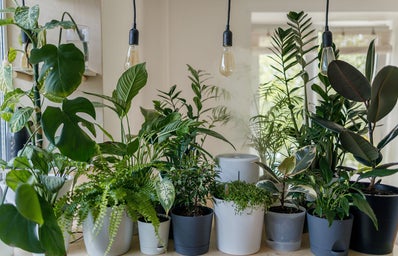Plant parenthood is supposed to be a relaxing experience. For me, keeping plants is the yang to balance out all of the yins in my life. But there are some plants that simply refuse to live in harmony with their owners. These are the top 3 houseplants that simply do not spark joy as well as some tips to keep them alive if you insist on keeping them in your home.
Fiddle Leaf Fig
Fiddle Leaf Figs drop leaves at everything. Too much light, too little water, or even from making eye contact. Especially in a dorm or apartment, I can see why FLF’s can be tempting to keep. They don’t take up much horizontal space and add a beautiful pop of green to your room. That is until your finicky leaf fig drops all of its leaves and you’re left with a beautiful stick surrounded by dirt. But if you truly insist on keeping one, there are a few things you can do to keep it alive as illustrated by The Spruce:
Water: During the growing season, (spring to fall) your fig should only be watered when the first inch of soil is dry. During the winter months, this can be reduced.
Lighting: When it comes to lighting, they do not like direct sun. They perform best with bright, filtered light. This can be achieved by putting your FLF near an east window or further away from a southern window.
Humidity/Heat: FLF’s do best with humidity between 30 and 65 percent. For heat, they require 60-85 degrees but do not do well when the heat fluctuates quickly.
Pests: They aren’t the most pest-prone plant but watch weekly for spider mites, scale, and general bacterial disease.
Tradescantia Zebrina
This plant may be a fast grower and easy to propagate but its appearance and the general discourse surrounding this plant’s common name makes my hatred toward this plant makes me want to drop kick this plant to the other side of the universe. Firstly, this plant is incredibly ugly. I hate to say it. But there are much prettier somewhat similar plants that don’t look like a ball of hair. For example, the callisia repens grows at the speed of zebrina while still looking gorgeous. But the zebrina looks like me going through puberty, wonky and lanky.
Also, there has been a lot of discourse within the houseplant community as to whether or not this plant should be addressed as their common name, the “wandering j*w.” (The word J*w is being censored throughout this article because the context in which it is used is derogatory.) Jewish members of the community have expressed discomfort toward this name because of its anti-Semitic history. The Wandering J*w is a Christian story of a man of the Jewish faith who refused to believe in Christ and was then sentenced to walk for eternity. During World War 2, this caricature of the wandering J*w was used to promote anti-Semitic ideology by the Nazis. To this day, the common name “wandering j*w” is still being used on nurseries and big box stores despite urges to use the scientific name or even just “wandering dude.” Sadly, a lot of non-Jewish plant community members have turned this into a freedom of speech issue. For me personally, if someone says that a phrase hurts them, I’m not going to say it but that’s beside the point. Back to the actual issue at hand: this awful plant. I think that buying a plant that is labeled as a “wandering j*w” tells companies that we are complicit in their macro-aggressive behavior.
If for some reason you still want to keep this plant, here are some tips (courtesy of Petal Republic):
Watering: When the top two inches of soil are dry.
Lighting: These plants prefer bright indirect light. They wildly prefer at least six hours of light a day.
Humidity/Temperature: They prefer temperatures of 60-85% and are more tolerant of low humidity in comparison to other houseplants.
Pests: Not very prone to pests.
Calatheas
Having to include these on this list hurts my heart because they are so gorgeous. Some of my favorite plants (aesthetic-wise) are calatheas. The minimalistic look of a calathea ornata really gets me going. I could stare at calathea musaicas for hours on end. But sadly, they are very high maintenance. Luckily, I have compiled a list of ways to keep your calatheas somewhat healthy.
Watering: ABSOLUTELY do not use tap water. These plants are incredibly sensitive. Instead, I would collect rainwater or use bottled water if you’re fancy like that. Calathes require more water than most houseplants and do not like their soil to dry out. While you should not water on a schedule, they tend to need to be watered twice a week during the growing season.
Light: Indirect light. Their leaves are very sensitive and will burn with direct light.
Humidity/Temperature: According to Indoor Garden Nook, Calatheas require humidity levels of 50% to 60%. If you are worried about damaging your walls with a 60% humidity level, you can use a humidity dome with a pebble tray to maintain a small, enclosed space with high humidity. For temperature, they need to be between 65-80 degrees Fahrenheit.
Whether it be because of their finicky nature, crispy edges or even anti-Semitic history, these plants do not spark joy. If you are trying to get into plants for your mental health, these are definitely not the plants for you. Just get a pothos instead.

